Cats meow, but not at each other – it’s primarily for us humans. These vocalizations are a fascinating way our feline companions communicate their needs, desires, and even complaints. Understanding the nuances of Cat Meowing can deepen the bond with your pet and provide valuable insights into their emotional state. Let’s explore the different types of meows and what they might mean.
The Kitten Meow: A Cry for Care
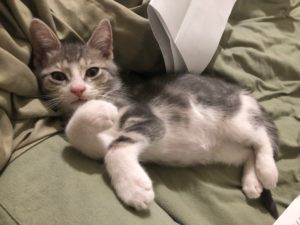 A cute kitten meowing, showcasing kitten vocalization.
A cute kitten meowing, showcasing kitten vocalization.
The kitten meow is perhaps the most endearing of all feline vocalizations. Characterized by a high-pitched, short “mew,” this sound is primarily used by kittens to communicate with their mothers. It’s their way of saying, “I need you!” whether it’s for nursing, warmth, or simply comfort. Interestingly, cats largely abandon meowing at each other as they mature. The fact that adult cats continue to meow at humans is a testament to how they’ve adapted their communication to interact with us. You might notice your adult cat reverting to this sweet kitten meow when they want your attention, especially when seeking food or affection. My own 11-year-old cat, Pinky, greets me with kitten mews every morning, a clear signal that breakfast time has arrived!
The Welcoming Meow: Happy to See You Home
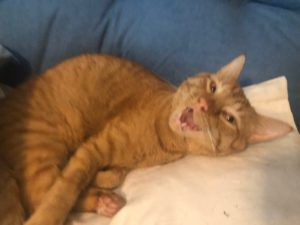 A Siamese cat happily meowing as a welcome greeting.
A Siamese cat happily meowing as a welcome greeting.
There’s nothing quite like returning home and being greeted by a chorus of happy meows. This “welcome home meow” is often a joyful sound, sometimes consisting of several meows in quick succession. Breeds like Siamese cats are particularly known for their talkative nature and expressive meows, using a variety of vocalizations to convey different moods. This greeting meow is often accompanied by physical gestures, like rubbing against your legs. It’s as if they are saying, “You’re back! You’re mine again!” Pay attention the next time you walk through the door; those happy meows are a clear sign of affection and excitement at your return.
The Answer Back Meow: Engaging in Conversation
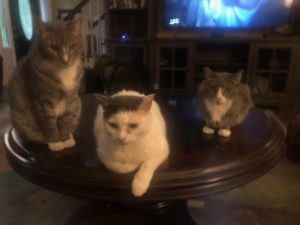 A cat meowing in response to a question about food, indicating conversational meowing.
A cat meowing in response to a question about food, indicating conversational meowing.
Cats are intelligent creatures and can learn to associate words and phrases with specific actions. The “answer back meow” is a perfect example of this. Many cat owners find their feline friends responding vocally when asked questions, especially those related to food. If you routinely ask, “Do you want to eat?” before preparing their meal, you might notice your cat responding with an enthusiastic “meow!” This is a single, often high-pitched meow of agreement or acknowledgment. You can even encourage this behavior by associating a question with a positive action, like giving a treat. Consistent repetition will help your cat make the connection and soon, a simple question will elicit a delightful meow in response.
The Attention-Seeking Meow: Demanding Your Affection
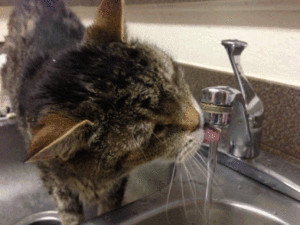 A tabby cat meowing for attention while standing on furniture, displaying attention-seeking meowing.
A tabby cat meowing for attention while standing on furniture, displaying attention-seeking meowing.
When a cat wants your attention, they will certainly let you know! The “need for attention meow” is often a series of drawn-out meows, sometimes accompanied by specific behaviors to ensure they are noticed. Cats might position themselves strategically, such as on a high surface to be at eye level, and then unleash a series of insistent meows. This vocalization is frequently paired with body language like a bowed head, inviting you to offer scratches and pets. If their initial meows are ignored, they might escalate their tactics by following you around, rubbing against your legs while continuing to meow, until they have successfully captured your full attention and affection.
The Complaint Meow: Voicing Displeasure
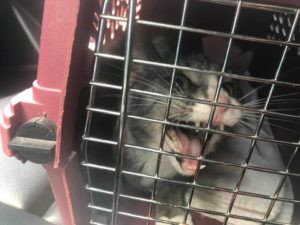 A cat meowing in a bathtub, representing a complaint meow in a situation of protest.
A cat meowing in a bathtub, representing a complaint meow in a situation of protest.
Not all meows are pleasant requests; some are clear expressions of dissatisfaction. The “meow of complaint” is a protest vocalization, often described as a loud, wailing, and drawn-out sound. You’ll typically hear this meow when your cat is denied something they want or is in a situation they dislike. For instance, a cat excluded from a room might voice their protest with persistent complaint meows. Clever cats quickly learn that these insistent meows can be effective in training their owners to fulfill their desires. They can be remarkably persistent and relentless when expressing their displeasure!
The Help Me Meow: A Call for Assistance
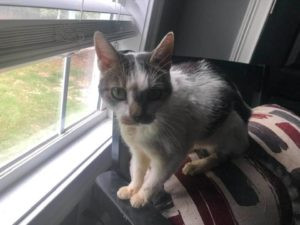 A cat at the vet, possibly exhibiting a 'help me' meow in a stressful environment.
A cat at the vet, possibly exhibiting a 'help me' meow in a stressful environment.
The “help me meow” can be easily confused with the kitten meow due to its similar high-pitched and short nature. However, it often carries a sense of urgency and panic. These meows tend to be louder and more frantic, sometimes sounding like they end on a questioning note, “mew?”. This type of meow is a clear indication that your cat is in distress and needs your help. Perhaps they are trapped, injured, or feeling unwell. It’s crucial to pay close attention to this meow and investigate the situation to ensure your cat’s safety and well-being.
The Senior Meow: Vocalizations of Age
As cats age, changes in their behavior and health can manifest in their vocalizations. The “senior meow” often presents as an increase in general vocalization. Older cats might meow more frequently and sometimes seemingly without an obvious reason. You might find your senior cat meowing in seemingly empty rooms or staring at walls. While some of this increased vocalization can be attributed to age-related cognitive decline or sensory changes like vision loss, it’s essential to rule out any underlying medical issues. A sudden increase in meowing in an older cat warrants a veterinary visit to check for pain, cognitive dysfunction, or other health problems.
Understanding the different types of cat meows is a vital step in better communicating with your feline companion. By paying attention to the pitch, volume, and context of your cat’s meows, you can gain valuable insights into their needs and emotions, strengthening your bond and ensuring their well-being.

